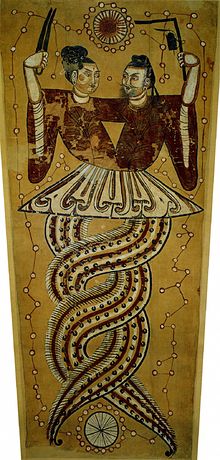Fu Xi

Fu Xi ( Chinese 伏羲 , Pinyin Fú Xī ) or Pao Xi ( 庖 牺 , Páo Xī ), Tai Hao ( 太昊 , Tài Hào ), also Fúxī or Fuxi , is said to have been the first of the Chinese great emperors , whose myths in the early Zhou period came up. According to legend, he is also the ancestor of humans.
He is said to have invented the Eight Trigrams of Yijing (I Ching, Book of Changes) by meditating on heaven and earth , and he is said to have brought people melody and music. The order of the eight trigrams and 64 hexagrams was brought into connection with his name and was viewed in Europe as a formal analogy to the dual system . He is said to have taught people to use nets for hunting and fishing and knotted cords to measure time and distance. He is also said to have invented medicine. Nu Gua is often portrayed as his wife . Supposedly he learned the art of writing from a learned dragon. He is said to have met him on the banks of the Yellow River .
During the Han period , Fu Xi became the god of the east and spring and his seat was the rectangular earth altar . On wall reliefs from the Han Dynasty, he is often depicted as a contortionist together with Nü Gua.
A Ming Age temple of Fu Xi from 1490 is located in Tianshui in the Chinese province of Gansu .
Lifetime and reign
Although Fu Xi undoubtedly belongs to the realm of legend, there are various proposals to date his reign.
- According to calculations by the Jesuit missionary Martino Martini in the 17th century, Fu Xi is said to be 2952–2838 BC. Have ruled.
- The reign of 2852-2738 BC is also often mentioned. Called BC.
- The sinologist and translator James Legge gave the fictional date of birth of Fu Xi as 3322 BC. Chr .
Fuxi and the trigrams
literature
- Hans-Wilm Schütte: China (= Baedeker Allianz travel guide ). 8th edition. Baedeker, Ostfildern 2009, ISBN 978-3-8297-1109-8 .
- Astrid Zimmermann, Andreas Gruschke : When the world egg broke. Myths and Legends of China. Hugendubel, Kreuzlingen et al. 2008, ISBN 978-3-7205-3052-1 .
Web links
Individual evidence
- ↑ https://www.chinahighlights.com/tianshui/attraction/fuxi-temple.htm
- ↑ DE Mungello: Curious country. Jesuit accommodation and the origins of sinology. Honolulu 1989, p. 132 PDF .
- ↑ For example in: Mathews Chinese-English dictionary, 13th ed. 1975, Appendix p. 1165.
- ↑ James Legge (ex.): The sacred books of China. I Ching, 2nd ed., P. 5 PDF .
| predecessor | Office | successor |
|---|---|---|
| - |
Mythical emperor of China unclear |
Shennong |

